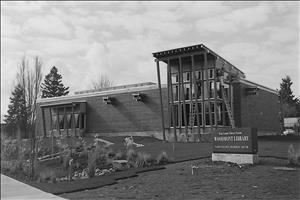On March 25, 2000, the King County Library System (KCLS) holds a dedication ceremony for the Woodmont Library, 12 days after the library first opened to the public. The new library, located at the corner of S 268th Street and Pacific Highway S in Des Moines, is a long-awaited replacement for the Redondo Library in the nearby neighborhood of Redondo Beach, which had closed in 1976. The Woodmont Library is 5,250 square feet in size, eight times larger than its predecessor.
Filling a Need
At least since 1965, KCLS had recognized a need for a library in Woodmont, an area located south of what were then the city limits of Des Moines and north of Federal Way. The need for a library in that part of southwest King County was compounded by the 1976 closure of the Redondo Library in the Redondo Beach neighborhood southwest of Woodmont, and by the area's continuing commercial and residential growth. Funds for a new library became available when county voters in 1988 approved a $67 million bond measure to fund KCLS capital improvements. Groundbreaking for the Woodmont Library at 26809 Pacific Highway S was held in June 1999. By then, both the Woodmont and Redondo Beach neighborhoods had been annexed by the City of Des Moines.
The Woodmont Library opened on March 13, 2000, with a collection of 25,000 books, along with video cassettes, compact discs, and other materials. The public responded enthusiastically. Patrons checked out more than 5,000 items in the library's first week of operation, with the official dedication still nearly a week away.
Dedication Ceremonies
The official opening ceremonies were held on March 25, 2000, with performances by a troupe of clowns, a magician, and an African music and dance company, and the dedication of a time capsule to be opened in 2020. The program for that day's events offered this description of the new library:
"Designed by Bassetti Architects and contracted by D. C. Engelmann Construction, Inc., the building distinguishes itself as a part of the commercial arterial of Pacific Highway South and the surrounding residential neighborhoods. A brick wall faces the commercial highway, while the side and entrance facing the residential neighborhoods is covered with wood siding and protected by an outdoor post.
"A glass and wood framed tower pours light into the masonry clad public reading room, constructed to withstand the exterior noise of Pacific Highway South and the SeaTac flight paths" ("Open House ...").

